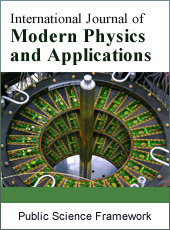International Journal of Modern Physics and Applications
Articles Information
International Journal of Modern Physics and Applications, Vol.5, No.3, Sep. 2019, Pub. Date: Nov. 21, 2019
Structural Investigations on Sodium Rich Silicate Glass Ceramics
Pages: 55-59 Views: 1796 Downloads: 422
[01]
Gomaa El-Damrawi, Glass Research Group, Physics Department, Faculty of Science, Mansoura University, Mansoura, Egypt.
[02]
Amal Behairy, Basic Science Department, The High Institute of Engineering and Technology, New Damietta, Egypt.
[03]
Riham Atef, Chemical Engineering Department, The High Institute of Engineering and Technology, New Damietta, Egypt.
Glasses in the system x (Na2O)(100-x) SiO2, (40≤ x ≤ 65 mol%) were prepared using ordinary cooling technique. The presence in the silicate network of relatively high concentrations of Na2O has been found to have a significant influence on its microstructure. Structural changes in the studied glass network were followed by DSC (Differential Scanning Calorimeter), XRD (X-Ray Diffraction), TEM (Transmission Electron Microscopy) and NMR (Nuclear Magnetic Resonance). Addition of up to 50 mol% Na2O to SiO2 results in breaking some of Si-O-Si bonds and as a direct result non-bridging oxygen atoms (NBO) are the well-formed species. But in the modifier-rich silicate glasses (Na2O = 50 and 65 mol%), beside formation of NBO ions, a relatively high portion from Na2O was consumed to form crystalline clusters species. In such the case, Na+ ions were proved to have six and seven coordination numbers with oxygen ions as a direct first neighbor. These types of coordinated sodium are evidenced (from 23Na NMR spectroscopy) to be dominant in the modifier rich glasses. The coordination number of Na is increased and the coordination of silicon atoms is decreased with increasing Na2O content. TEM, (EDP) and XRD spectra in correlation with NMR results have confirmed the presence of crystalline cluster species enriched with Na+ ions.
Na Coordination Sites, Clustered Species, Morphological Investigations
[01]
V. N Bykov, A. A. Osipov, V. N Anfilogov,. Phys. Chem. Glasses 41 (2000) 10.
[02]
C. C Lin, L. C Huang, P Shen. J. Non Cryst. Solids 351, (2005) 3195.
[03]
C. C Lin.; S. F Chen.; L. G Liu.; C. C Lee. Mater. Chem. Phys. 123 (2010) 569.
[04]
H Maekawa, T Maekawa, K. Kawamura, T Yokokawa,. J. Non Cryst. Solids 127 (1991) 53.
[05]
G El Damrawi, K Abd Elnur, R. M Ramadan. Silicon 2 (2018) 1-6.
[06]
A. Behairy. J Advanc. in Phys. 14 (2018) 5653.
[07]
T. Sekiya. N Mochida. A Ohtsuka, M Tonokawa. J. Non. Cryst. Solids 144 (1992) 128.
[08]
I. Avramov. G Guinev, A. C. M Rodriguesn. J. Non Cryst. Solids 271 (2000) 12.
[09]
D. Holland., J. Bailey. G. Ward., B. Turner, P. Tierney, R. Dupree. Solid State Nucl. Magn. Reson. 27 (2005) 16.
[10]
V. G. Plotnichenko, V. O Sokolov, V. V Koltashev, E. M Dianov, I. A Grishin, M. F Churbanov, Opt. Lett. 30 (2005) 1156-1158.
[11]
A. Karamanov, M. Pelino. J. Eur. Ceram. Soc., 19 (1999). 649.
[12]
G. Karaduman, A. E. Ersundu, M. Çelikbilek, N. Solak, and S. Aydin. J. Eur. Ceram. Soc. 32 (2012). 603.
[13]
M. Çelikbilek, A. E. Ersundu., S. Aydin. J. Amer. Ceram. Soc 96 (2013). 1470.
[14]
J. C. McLaughlin. S. L. Tagg, J. W. Zwanzige. J. Phys. Chem. B. 105 (2001) 67.
[15]
D. Timpel. K. Scheerschmidt. H Stephen. S. Garofalini. J. Non. Cryst. Solids. 221 (1997). 187.
[16]
M. T. Alam, J McLaughlin. C. C. Click, S Conzone. R. K. Brow. T. J. Boyle., J. W. Zwanziger. J. Phys. Chem. B 104 (2000). 1464.
[17]
V. N. Bykov, V. E Eremyashev, V. N Anfilogov. Inorganic Materials 46 (2010). 1265.
[18]
H. Eckert. Zeitschrift für Physikalische Chemie 224 (2010). 1591.
[19]
B. Gee. H. Eckert. J. Phys. Chem. 100 (1996). 3705.
[20]
G. N. Greaves, A Fontaine, P Lagarde, D Raoux, S Gurman. Nature 293 (1981). 611.
[21]
J. Chinnababu, V. Chandramouli. Ind. J. Pure Appl. Phys., 47 (2009). 241.
[22]
R. A. H. El-Mallawan, I. A Ahmed. J. Mater. Sci. 43 (2008). 5131.
[23]
G. El-Damrawi, H. Doweidar, H. Kamal. Silicon 9 (2017). 503.
[24]
G. El Damrawi. A. K. Hassan, A. Shahboub. Magn. Reson. Solids 20 (2018). 18202.
[25]
S. Sakida, S. Hayakawa, T. Yoko. J. Am. Ceram. Soc. 84, (2001). 836.

ISSN Print: 2381-6945
ISSN Online: 2381-6953
Current Issue:
Vol. 7, Issue 1, March Submit a Manuscript Join Editorial Board Join Reviewer Team
ISSN Online: 2381-6953
Current Issue:
Vol. 7, Issue 1, March Submit a Manuscript Join Editorial Board Join Reviewer Team
| About This Journal |
| All Issues |
| Open Access |
| Indexing |
| Payment Information |
| Author Guidelines |
| Review Process |
| Publication Ethics |
| Editorial Board |
| Peer Reviewers |


